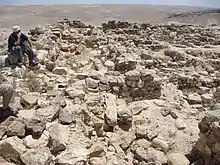Horvat Uza
Horvat Uza (Hebrew: חורבת עוזה) is an archaeological site located in the northeast of the Negev desert in Israel. The site is located in the east of the Arad Valley and overlooks Nahal Qinah (Qinah Valley). In ancient times, forts were established there to control the wadi road, linking Judea to Arabah and the territory of Edom. It was mentioned as Qina by Josephus in book 15 of his Antiquities.[1]
חורבת עוזה | |
 Hurvat Uzza, overlooking Kina River at Arad Valley, Israel. | |
 Shown within Israel | |
| Location | |
|---|---|
| Region | Negev |
| Coordinates | 31°12′33″N 35°09′56″E |
| Type | Fortress |
| History | |
| Periods | Iron Age |
| Cultures | Judahites |
Several inscribed potsherds with inscriptions in Hebrew, dated to the 7th-century BCE, were found in Horvat Uza.
References
External links
- "Inscribed potsherd (ostracon), Horvat Uza, Iron Age II, 7th century BCE, Ink on pottery". The Israel Museum, Jerusalem. Retrieved 27 May 2021. Photo of Horvat Uza ostracon, inscribed with the text "Ten: Menahem son of H[…]; Neryahu son of Semak[yahu]; Neryahu son of Mishk[an]ya[hu]; Netanyahu son of Hoteb; Uriyahu son of Shelem[yahu]; Gedalyahu son of Uriyah[u]; Yadinyahu son of Shephat[yahu]; Hoduyahu son of […]."
This article is issued from Wikipedia. The text is licensed under Creative Commons - Attribution - Sharealike. Additional terms may apply for the media files.